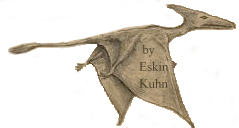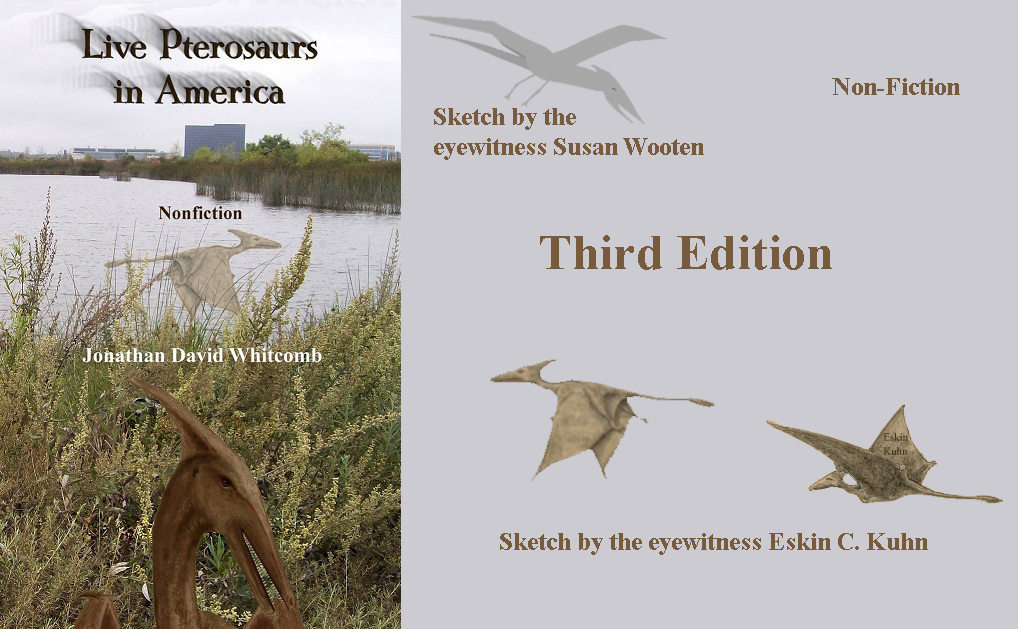
Mentioned in the Old Testament as deadly to the Israelites who had recently escaped Egypt, the “fiery flying serpent” has been assumed, by some people in modern times, to have been a species of venomous snake that strikes as if it were flying into the air, and “fiery” has been interpreted as a description of the burning pain from its bite. But this approach judges two words technically incorrect and only one correct: not literally fiery, not literally flying, but a literal snake. Could the actual animal be more like the reverse? I believe so. Please consider recent research and investigations (1).
Problems with the “snake” interpretation — Consider Pterosaur
Consider some problems with the “snake” interpretation. In our modern technical world, we are struck by an ancient Hebrew phrase. “Fiery flying serpent,” directly interpreted, appears unconnected with any living thing, or at least unclassified by modern standard biology as living at the time of Moses. Some Bible scholars have assumed that a story of anything like a flying fire-breathing dragon could not have come from any real animal. Thus, to avoid a strange direct interpretation, we’ve been fed indirect meanings for “fiery” and “flying.”
If the Israelites had been attacked by an animal well known to us, with a clear label, we would feel no need for oblique interpretations. And if we were always humble enough to admit that our modern science might not include knowledge of every dangerous animal encountered by ancient Israelites, we would feel no need for continuous obliqueness.
An oblique response can lead to unintentional injury to reasoning. If a human who was bitten by a snake felt like the wound was burning, why label the snake with that sensation? It seems to me much more likely that “fiery” refers to something like fire in the animal, for that is what is being labeled: It is the animal.
And why label any snake with “flying?” So many better descriptions come to mind for an animal that might ambush, surprise, or terrorize its victims from the ground. Warriors in battle might be described as “flying” upon their enemies, but there is no doubt about that meaning. A non-human that flies has wings, so let’s consider that possibility. And, if I have been informed correctly, the original Hebrew relates to a back-and-forth or up-and-down motion, like the flight of a bird. It fits with a battle where swords constantly swing back-and-forth or up-and-down; it does not fit with a single forward-motion strike of a snake.
Two writers, Ronald P. Millett and John P. Pratt, have done extensive research under the traditional assumptions, including the idea that the strike of a venomous snake would cause that snake to be labeled “flying.” But that comes, I believe, from a far-less-obvious deeper assumption, one that is buried too deeply to be noticed by most researchers (buried deeper than any snake in the sand): the assumption that all Rhamphorhynchoid (2) pterosaurs became extinct before the time of Moses.
Whatever the species (long-tailed pterosaur or true snake), we need to remember that God sent those animals among the Israelites for a purpose. The people did not just happen to walk through venomous-snake territory at that time; they were being tested or disciplined by God. Of course we should avoid any argument about what species of animal is involved. But something more important deserves our attention here, and it deserves further reasoning.
Another problem with the snake interpretation strikes me to the heart. What is the usual symbolism here? Who does the snake usually represent in the Old and New Testament? Satan, of course. Does it seem likely that a true serpent would be used to symbolize Jesus Christ? If the “fiery flying serpent” were a snake, Moses would have killed one of them and dragged the dead snake on the ground, to symbolize God’s victory over Satan. He would not have given the Israelites the symbol for Satan, to look up to a common snake for healing or salvation.
I suggest that the symbolic source of salvation, held up by Moses for the people to see, had no close resemblance to the animal used by Satan to tempt Adam and Eve and cause the fall of humans in the Garden of Eden.
A better symbol for Jesus Christ
Unless I am greatly mistaken, the form that Moses held up on a pole resembled what is symbolically and literally higher than any lowly snake. It was an animal that could never be mistaken for a regular snake, and that difference is shown by two words: “fiery” and “flying.” Those two words symbolically put Jesus Christ higher than Satan, for to the power of flight (with wings) is added the glory of light.
A winged creature that glows
A more direct interpretation (normal meaning of most words), strange as it may appear, is of a winged creature that only somewhat resembles a snake, and it appears to burn or give off a fire. Critical new information has come to light in recent years, making a significant case for a non-snake that looks just enough like a snake for the ancient Hebrews to use “serpent” as part of its name. This long-tailed animal flies while glowing with bioluminescence (3).
In 2003, I began studying eyewitness accounts of strange flying creatures in Papua New Guinea. As a forensic (legal) videographer, I had produced day-in-the-life and settlement documentaries for attorneys, and had an eye for witness credibility in video recordings. I was greatly impressed by the videotaped testimonies of natives on Umboi Island (4), where the name for a large nocturnal flying creature is “ropen” (not to be confused with “byung,” which refers to the Flying Fox fruit bat).
Ropen Expeditions in Papua New Guinea
By late-2004, I had interviewed three Western eyewitnesses who had seen giant pterosaur-like animals flying in the southwest Pacific. They confirmed to me what I had learned from the videotaped interviews of natives of Umboi: Giant pterosaurs live in Papua New Guinea and Australia. I explored (5) Umboi Island before the end of the year and interviewed many natives. I returned to the United States convinced that “ropen,” “indava,” and “wawanar” refer to the same kind of giant nocturnal flying creature, perhaps even the same species. Descriptions strongly suggest a Rhamphorhynchoid (long-tailed) pterosaur. Amazing!
Also amazing is the bioluminescence, for many (if not all) of these large nocturnal flying creatures seem to control a bright glow that helps them catch fish or other food on reefs. On Umboi Island, it appears that one dominant ropen moves from one reef to another, around the island, on various nights. It shines brightly for five to six seconds, apparently just before landing (perhaps another purpose for the glow: to help it to land safely). It has been seen by many islanders and by a few Western visitors.
The bioluminescence of modern ropens may cause natives of Papua New Guinea to associate the creatures with fire. This may also have caused the ancient Israelites to label a similar creature with “fiery.” These more-direct interpretations of “fiery” and “flying” suggest that we interpret “serpent” indirectly: only somewhat like a venomous long-tail snake. (Yes, there is a case for Rhamphorhynchoid venom, cryptozoological though it may be.)
But why would the people of Moses label a winged creature with a name that included “serpent?” Consider a long-tailed lizard. Even with flaps of skin that allow gliding down from a tree, flying lizards have four legs, allowing that kind of animal to run on the ground. It is even less like a (long-tailed) Rhamphorhynchoid pterosaur. And what “flying” lizard could kill with venom? “Serpent” pulls out any feather-association of birds, inserts a snake-like tail, and injects venom into the association. For a living thing that flies, that one word gives us three attributes, not bad for one word, notwithstanding the animal itself seems to have been a non-snake, according to modern technical classification.
Having raised many reptiles in my younger years, I understand the fascination some modern biologists have with true snakes. But I think it is too much, for even the skinniest snake, to ask it to fly through this narrow flaming hoop, the traditional and apparently safe interpretation. We need to examine more closely “flying” and “fiery.”
After my expedition on Umboi Island, I met an American who had explored another area of Papua New Guinea a few years earlier. He had also searched for this creature in a remote jungle and, like me, had failed to see one. But he interviewed an old man whose nephew had died after being attacked by a glikioik (pronounced glee-key-oh-eek) . The flying creature had followed the man as he carried the boy to a clinic, but before they had arrived (the creature having given up the pursuit), unfortunately, the boy went into convulsions and died. The uncle told my associate that his nephew had no obvious wound or injury on the body.
If this story of the attack by a glikioik were all we had about the dangers of strange flying creatures, I could doubt. But there are other accounts of human death from large flying creatures in Papua New Guinea (6). In addition, we have non-Biblical ancient accounts of dangerous flying creatures in northern Africa and in what is now called the “Middle East.” All these suggest that the ancient Israelites had encountered venomous Rhamphorhynchoid pterosaurs. The Israelites may have named them with “serpent” because, with wings folded up while at rest, the creatures with long tails may have somewhat resembled serpents.
1 “The Bible and Pterosaurs,” John Goertzen
2 Apparent Rhamphorhynchoid pterosaur observed by a psychologist
3 Glowing creatures videotaped in Papua New Guinea
4 Eyewitnesses of ropen on Umboi Island
5 Whitcomb Expedition of 2004 to Umboi Island, Papua New Guinea
6 Pterodactyl Kills Fisherman in northern Papua New Guinea
Also: Creation Research Society Quarterly: Woetzel’s paper “The Fiery Flying Serpent”
___________________________________________________________________
The best-selling non-fiction cryptozoology book that has a special emphasis on sightings of apparent pterosaurs—that is Live Pterosaurs in America, third edition (usually at a discount on Amazon).




6 Replies to “New view on the “fiery flying serpent””
Comments are closed.